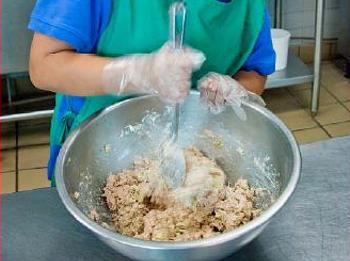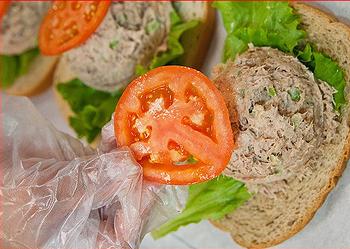Tuna-Loving Kids at Risk of Mercury Poisoning
MONTPELIER, Vermont, September 20, 2012 (ENS) – Children who love to eat tuna fish may be at greater risk of mercury poisoning than anyone has realized, finds the first study on mercury in school lunches published Wednesday by the Mercury Policy Project.
Analysis of the research results shows that frequent tuna eaters can be exposed to more than 40 times the current federal definition of safe mercury exposure, which report co-author Dr. Ned Groth calls “way out of date and not protective enough.”
The human nervous system is very sensitive to all forms of mercury. Research has shown that children poisoned by mercury may develop problems of the nervous system with learning and cognitive impairment, and suffer disorders of the digestive system and kidney damage, according to the federal Agency for Toxic Substances.
Dr. Groth warns that while individual children vary widely in how mercury affects them, frequent tuna consumers can experience “subtle effects on cognitive ability and learning when exposed to this poisonous element.”
The report, “Tuna Surprise,” contains the first test results for mercury in tuna sold to schools and assesses children’s mercury exposure from canned tuna.

Tuna fish is prepared for a school lunch in Arlington, Virginia. (Photo courtesy U.S. Dept. of Agriculture)
Mercury Policy Project researchers tested the mercury content of 59 samples, representing eight brands of tuna, sold to schools in 11 states.
An inexpensive and nutritious low-fat protein source, canned tuna is served through the federally subsidized school lunch program. And schools may be switching to leaner protein sources this fall as they implement the new school lunch standards.
Independent studies, not available when government advisories were issued eight years ago, indicate that adverse effects of methylmercury occur at much lower levels of exposure than previously thought.
Canned tuna is by far the largest source of methylmercury in the U.S. diet and accounts for nearly one-third of Americans’ total exposure to this toxic mercury compound.
“As far as we know, no one has previously tested this market sector,” said Michael Bender, MPP’s director.
Testing of tuna sold to schools showed that the tuna contains mercury levels similar to what other investigations have found in canned tuna sold in supermarkets. Albacore or “white” tuna had much higher mercury levels than did “light” tuna, and mercury levels in both types were highly variable.
The report advises schools and parents not to serve any albacore tuna to kids and to limit consumption of light tuna to twice a month for most kids and only once a month for smaller children, under 55 pounds.
“Most children are already consuming only modest amounts of tuna and are not at significant risk,” said Bender. “So the focus really needs to be on kids who eat tuna often, to limit their mercury exposure by offering them lower-mercury seafood or other nutritious alternatives.”
One specific warning in the report is to avoid tuna from Latin American countries, particularly Ecuador, as it tested higher for mercury content than tuna produced in other countries.
Currently, American kids eat twice as much tuna as they do any other kind of fish, and one out of every six U.S. seafood meals is canned tuna.
“Fish, including tuna, is generally a nutritious part of a healthy diet,” said Sarah Klein, staff attorney in the Food Safety program at the Center for Science in the Public Interest. “But especially for our littlest, most vulnerable children, we have to make sure the risks from mercury in tuna don’t outweigh tuna’s benefits. We’re urging parents and schools to limit children’s tuna consumption and, when they do serve it, to choose lower-mercury options.”

Tuna fish is served for lunch at schools across the United States. (Photo courtesy USDA)
“As the report states, light tuna has one-third as much mercury as albacore does,” said Eric Uram of Coalition for Safe Minds. “But contrary to the current federal fish consumption advisory, it is definitely not a low-mercury fish.”
Dr. Groth, an environmental health scientist based in Pelham, New York, analyzed a variety of scenarios in which children of different ages ate different amounts of tuna with different mercury levels, and examined the relative exposure and risk from each scenario. Exposures in those scenarios ranged from less than one-quarter of to more than 40 times the current federal definition of safe exposure.
“Kids who eat tuna frequently can easily get very high mercury doses,” says Dr. Groth. “Some of the larger doses are clearly far too high to be acceptable.”
The mercury in tuna comes from two sources – human activities and natural processes.
Dr. Groth told ENS, “For billions of years mercury has been leaching out of the land. It occurs in rocks and in volcanic emissions. Since the Industrial Revolution, he explained, “humans have been putting mercury into air from coal burning. It falls into oceans and on rivers and wetlands. Once there, bacteria in those environments eat mercury and convert it to methylmercury – this compound gets into the food chain.”
Methylmercury is absorbed by algae in ocean water and becomes more and more concentrated as it moves up the food chain – small animals eat the algae, small fish eat the small animals, medium fish eat the smaller fish and top predators such as tuna that eat the medium-sized fish have the highest concentrations of mercury in their bodies.
“This is largely a natural process responding to both natural and pollution inputs of mercury,” said Groth. “If you look at mercury samples from the 19th century, they had mercury in their tuna too – it’s a fact of life.”
“It’s a shame that such a great source of inexpensive protein is contaminated with mercury,” says Dr. Catherine Thomasson, executive director of Physicians for Social Responsibility, which co-released the report. “To reduce risk, we need to both reduce children’s exposure to tuna and reduce mercury pollution the majority of which is from coal-burning power plants.”
With this in mind, the report recommends:
No child should eat tuna every day and children should not eat albacore tuna. Albacore or “white” tuna contains triple the mercury level of light tuna; nothing justifies tripling a child’s mercury dose.
Children weighing more than 55 pounds should not eat more than two servings of light tuna per month. This amount of tuna (six ounces) is more than the average child currently consumes; the mercury dose it contains is acceptably low in risk.
Children up to 55 pounds should consume no more than one tuna meal per month. Because of their smaller body size, an added margin of caution is appropriate for younger children.
Parents and schools should offer children other seafood choices, such as shrimp and salmon, which are just as nutritious but contain far less mercury.
The U.S. Department of Agriculture’s School Lunch Program should phase out commodity purchases of canned tuna, and replace it with lower-mercury alternative seafood items and other extra-lean protein sources.
Parents should monitor their children’s canned tuna consumption at school and ensure that the total consumed at home and at school does not exceed the recommendations for exposure.
“Tuna Surprise” was co-released Wednesday by the Center for Science in the Public Interest, Physicians for Social Responsibility, Coalition for Safe Minds, Environmental Health Strategy Centers, Got Mercury?, Clean Wisconsin, Massachusetts Clean Water Action, Vermont Public Interest Research Group and the European Environmental Bureau.
Copyright Environment News Service (ENS) 2012. All rights reserved.